Know the best material options for your hydraulic installation
Guarantee the comfort and functionality of your installations with a correct hydraulic installation
A quality hydraulic installation is a fundamental part of any engineering project, since it guarantees the comfort and functionality of all those residences, real estate developments or any building. For these reasons, it is important that they are carried out by specialized personnel.
As a first point, the hydraulic installations are designed based on the purpose and use in the building, for this, a set of pipes and connections must be considered, as well as their different diameters and materials, among other elements of specialized equipment, as well as the supply of hot and cold water for the comfort during personal and domestic hygiene must also be considered.
General information about a hydraulic installation
Before water is distributed for human use, it must be purified through a purification process so that it can be conveyed to communities by means of pumping equipment and piping systems, which depends on how it is supplied: by gravity, by pumping or a combination of the mentioned.
Once the water is received by the municipal network, the supply is distributed to the buildings by means of a supply system designed specifically for the use or purpose for which each building will be used. Part of this design is the supply of hot and cold water for the comfort of the end user, this system is known as hydraulic installation in a building. Therefore, this is constituted by a set of pipes, furniture, fittings such as valves, elbows and connections, and equipment such as heaters, pumps and hydropneumatics, which together carry the appropriate water supply to a building.
Characteristics to be met by a hydraulic installation

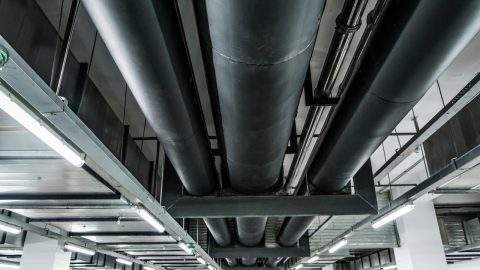
It should be noted that the design of a hot and cold water installation is based on the flow and pressure required in each piece of furniture.
That is why in order to have a proper functioning in a hydraulic installation it is essential to comply with the following requirements:
1. The design
It is an important point, since the correct design of the pipes will allow that these are not noisy and can distribute the water without excess of pressure, as well as that the expense or distribution is not reduced when another piece of furniture is in use.
2. Pipes and valves
The important points regarding pipes and valves are the following:
- Avoid contact with other installation, mainly when it comes to drainage. That said, we recommend that the general supply piping should have at least 1 meter separation with the drainage lines, as well as being placed in easily accessible areas to facilitate maintenance.
- After the municipal mains tap, upstream of the meter, a globe valve and a faucet should be installed.
- Likewise, cold and hot water pipes should be 20 cm apart; hot water outlets are always placed on the left side and cold water outlets on the right side.
- We also recommend that all units have a stopcock so that in the future, if there is a leak or the unit needs to be replaced, it will not be necessary to close the general stopcock of the installation, but only the stopcock of the unit in question.
- The standard heights of the pipes that feed the furniture from the finished floor level are: washbasin, 79 cm; toilet, 38 cm; shower faucet, 137 cm; shower outlet, 200 cm; sink, 90 cm.
- The bathroom and kitchen should be built close to each other, so that all the piping runs in the same path. This will avoid higher costs, energy losses and material savings.
3. About the storage elements
Regarding the water storage tanks, it is advisable to place them at least 50 cm from the roof floor to make their installation easier, as well as to place them at least 2 meters high from the furniture of use so that they have an adequate pressure.
4. The heater
For safety and comfort of the end user, the water heater must be installed in an open place, it is indispensable that it is never inside the room; as well as, it must have a safety valve or an expansion tank.
5. Validation of the installation
Finally, to ensure proper operation, a pressure test should be performed to check for leaks and if there is indeed adequate pressure.
Cold and hot water supply
In urban areas there are municipal services that provide potable water supply services through distribution networks, which studies the following types of supply, for both cold and hot water within a building.
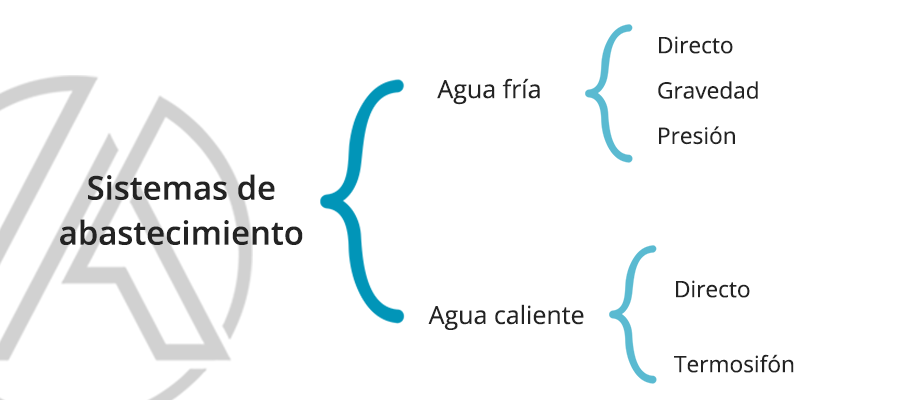
Main types of pipes, valves and fittings
Main types of pipes
A good choice of materials to be used in installations depends on the following factors:
- Site characteristics.
- Flow capacity.
- Costs
That is why, in the following table we describe some pipes with their characteristics and particular recommendations for their use.
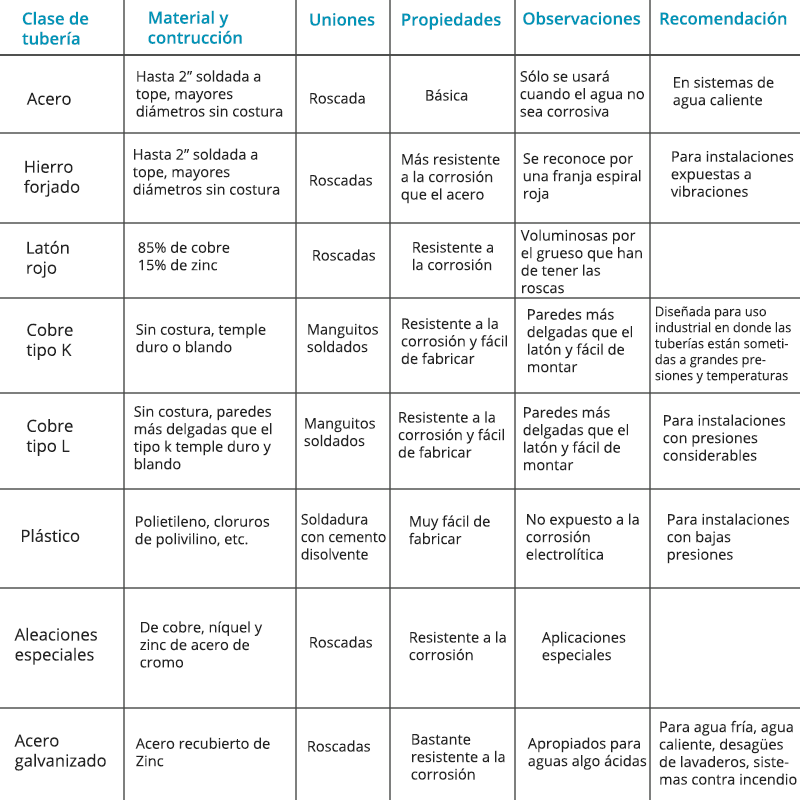
Main types of valves
Likewise, there is a great number of valves, taps and accessories that will allow a correct hydraulic installation, but to choose the right one, it must be determined based on a technical/economic study. Therefore, in the following table we describe superficially the main types of valves used in hydraulic installations.
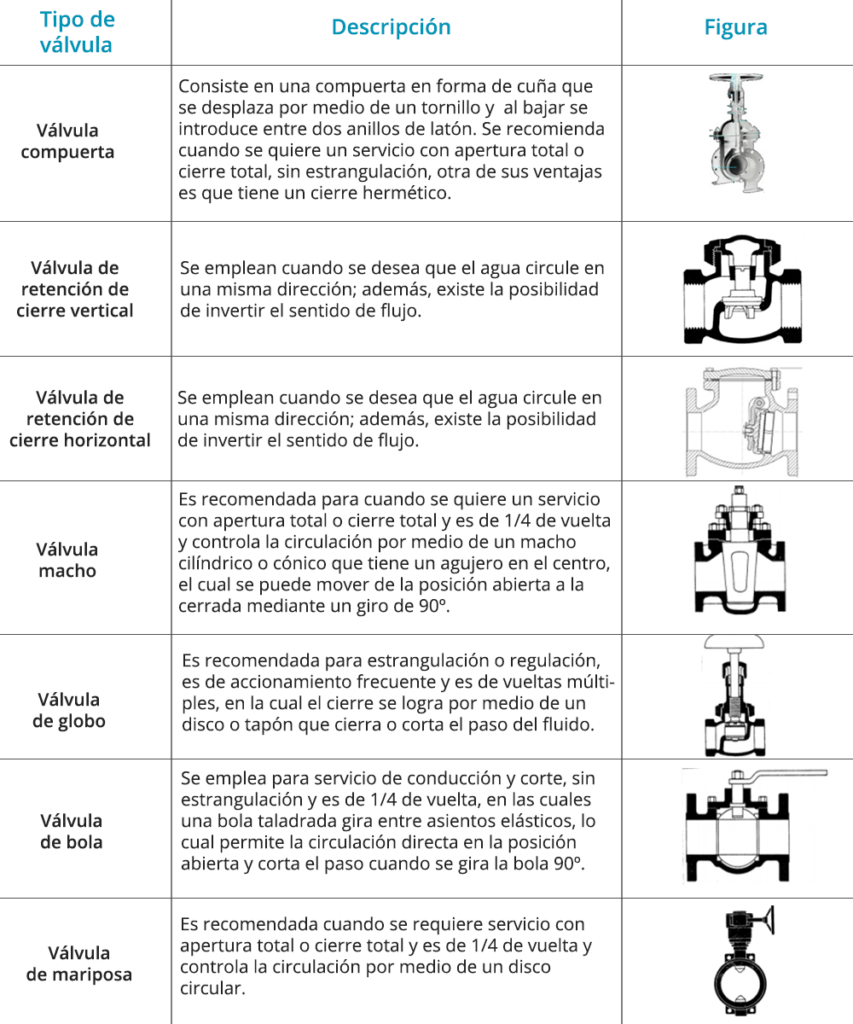
Main types of fittings for joints
There are several connections to join pipes, faucets and valves (elbows, tees, Y, reductions, plugs, etc), as well as they are distributed in different materials and these can be weldable or threaded. In the following image, we share with you elbows of 90, 60, tee, plugs and fundamental fittings to achieve changes of direction in the installation; the materials of these can be P.V.C., copper, carbon steel, stainless steel, galvanized steel, among others.
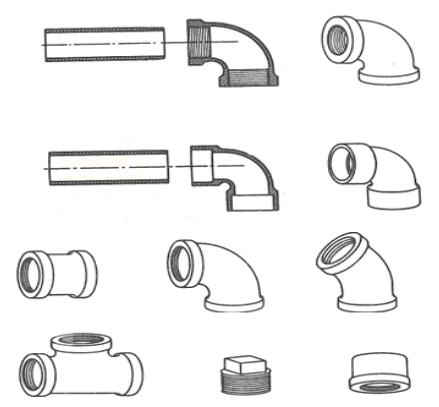
While the use of the right materials is key to a successful installation, the right design will ensure total end-user satisfaction, both for ease of maintenance and to avoid major repair costs.
If you want to learn more about proper design, please consult our expert advisors.
Sources: UNAM García Abraham (2012) Instalaciones en los edificios.

Comments
We are interested in your opinion, please leave us a comment